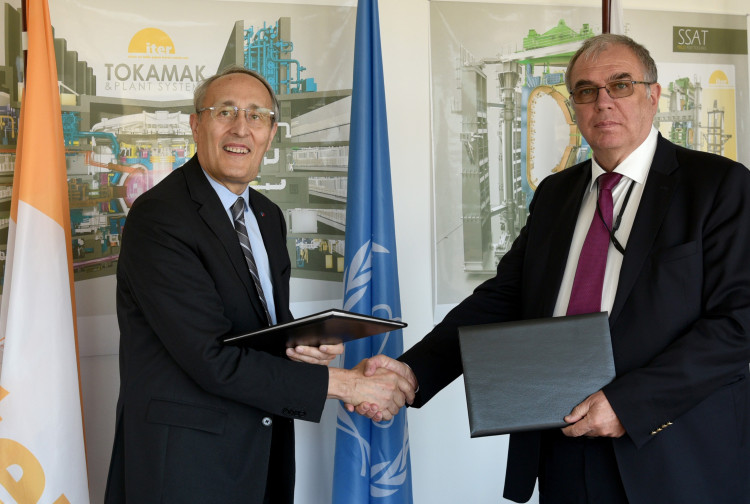The International Atomic Energy Agency (IAEA) and the ITER International Fusion Energy Organization have agreed to strengthen their cooperation in nuclear fusion research and related activities with the long-term goal of realizing fusion energy production on an industrial, power-plant scale.
Fusion research aims to develop methods to harness the power generated by the fusion of light nuclei, a process comparable to the energy production of stars. It holds the promise of abundant, safe and carbon free energy.
IAEA Assistant Director General and Chief Coordinator Cornel Feruță signed the agreement known as Practical Arrangements at the IAEA’s headquarters in Vienna this week. Mikhail Chudakov, IAEA Deputy Director General and Head of the Department of Nuclear Energy, who attended the 24th meeting of the ITER Council representing the IAEA, handed over the Practical Arrangements to ITER Organization Director-General Bernard Bigot at ITER’s headquarters in St. Paul-lez-Durance, France. The agreements that went into effect with Mr Bigot signing today expand and deepen a cooperation agreement from 2008.
IAEA Director General Yukiya Amano noted the importance of the new arrangements. “The challenge to achieve the goal of fusion power production can only be met through concerted international efforts. ITER’s impressive work plays a central role in this field,” Mr Amano said. “We look forward to our intensified collaboration.”
“The IAEA hosts a wide range of initiatives in fusion and is the key international organization in fostering global research in this area,” said Mr Bigot. “Our Practical Arrangements deepen the long tradition of cooperation between our organizations.”
Under the arrangements ITER will share its experience related to nuclear fusion safety and radiation protection with the IAEA and its 171 Member States, including those who are not members of ITER. ITER’s information would play an important role for the potential development of IAEA safety standards related to nuclear fusion as well as relevant nuclear security guidance. The two organizations will also implement educational initiatives on plasma physics and fusion engineering. They will coordinate activities in public outreach and will cooperate in knowledge management and human resources development.
ITER, located in southern France, is the world’s largest fusion experiment. Thirty-five nations collaborate to build a tokamak, a magnetic fusion device that has been designed to prove the feasibility of fusion as a large-scale and carbon free source of energy. ITER is scheduled to become operational in 2025.
The IAEA has long played an important role in fostering international fusion research. “Nuclear Fusion”, founded by the IAEA in 1960, is the leading journal in the field. Activities leading to the establishment of ITER were carried out under Agency auspices and the IAEA Director General is the Depository of the ITER agreement, which was signed in 2006. The IAEA’s biannual Fusion Energy Conference - next to be held in Nice, France, in 2020 - is the premier international gathering of fusion scientists and engineers.


